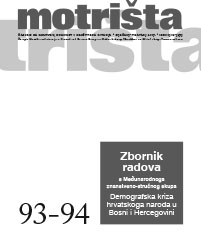Demografska kretanja u općini Konjic od prvoga službenog popisa u vrijeme austrougarske uprave do posljednjeg popisa 2013.
Demographic trends in the municipality of Konjic from the first official census in the Austro-Hungarian period to the last census 2013.
Author(s): Ivan AnđelićSubject(s): Demography and human biology, 19th Century, Pre-WW I & WW I (1900 -1919), Interwar Period (1920 - 1939), WW II and following years (1940 - 1949), Post-War period (1950 - 1989), Transformation Period (1990 - 2010), Present Times (2010 - today)
Published by: Matica hrvatska Mostar
Keywords: Konjic; population; wars; Muslims; Orthodox Serbs; Catholic Croats;
Summary/Abstract: Konjic municipality has an area of 1,346 km square and extends from municipalities Trnovo in the north to the municipalities Kreševo, Fojnica, Rama in the south-west and Jablanica municipality in the south. Konjic is spacious largest municipality in Bosnia and Herzegovina. Mainly located in the Neretva river basin, from the river source to Ostrošac, the hydro- reservoirs Jablanicalake. The Neretva valley with its major tributaries and many smaller rivers with vast fields of fertile alluvial sediments, abundant grasslands, forests and mild sub-Mediterranean climate is an extraordinarily area of people’s lives. According to archaeological sources and pinpointed sites people lived here even at a stone age from 2400 to 2200 year BC. In the age of metal (bronze and iron) there are located72 settlements in which we can say there lived from 5000 to 7000 because the population to live in families, and the family is counted from 50 to 100 people. In ancient times, which goes back to the Roman Empire occupation of areas Iliric to drop the Empire in 476thAD assume that the population grew due to the significant influence of non Illyrian population of the vast empire and because of the intensive development of the economy and the presence of huge military garrison for the defense of the invading Germanic tribes. Of course, in the early feudal period after the fall of the Roman Empire comes to the settlement of these areas by the Goths, the Avars, but not negligible immigration and Vlach elements. At that time appear and Slavic tribes. From 1463rd AD, with the fall of Hum countries and the Bosnian kingdom under Ottoman rule, begins a new era with completely different attitude. Population estimates at this time could be derived from the Turkish census of taxpayers where the current municipality of Konjic were 1,861 home-host, and we assume that every household had at least 6 members makes 11,166 residents. Interestingly, in 1469th the total number was 11,166 no Muslim inhabitants (Catholics, Orthodox, members of the Bosnian Church and only 5 Muslims). So, Islamization has completed in 1585th. During the Austro-Hungarian administration, there were four complete statistical list as follows: 1879th, 1885th, 1895th and 1910th. After the 1879th census, the total number of the municipality amounted to 14,284 inhabitants, of which 7,822 Muslims, Orthodox 2,041 and Catholic Croats 4,421 resident, and in 1910th the total number of the municipality amounted to 23,542 inhabitants of which 8,469 Catholics. For the duration of the state of Serbs, Croats and Slovenes, and then the Kingdom of Yugoslavia (1918 - 1941) there were two lists as follows: 1921 and 1931. After this first list is kept roughly the same population as per 1910th census. The Socialist Yugoslavia was held 6 list, as follows: 1948th, 1953rd, 1961st, 1971st, 1981st and 1991st. According to preliminary unofficial results of the inventory in the current state of Bosnia and Herzegovina from 2013th, the total population in the municipality of Konjic is 26,381 but it doesn’t have a national composition. According to unofficial data now in the municipality of Konjic lives less than 1,500 Croats - Catholics or 5.7 %.
Journal: Motrišta
- Issue Year: 2017
- Issue No: 93-94
- Page Range: 208-217
- Page Count: 10
- Language: Croatian

